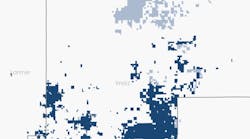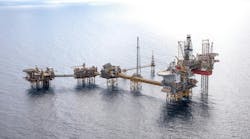Carigali-Triton Operating Co. (CTOC)-a joint venture of Malaysian state oil firm Petronas and US firm Triton Energy Corp.-has chosen a consortium headed by France's Technip SA to serve as turnkey contractor to develop the $800 million Cakerawala gas development project in the Gulf of Thailand.
Technip, South Korea's Samsung Heavy Industries Co., and Italy's Saipem SPA will install production and related facilities for an undisclosed lump sum.
Cakerawala field is located on Block A-18 in the 7,250 sq km Joint Development Area (JDA) between Thailand and Malaysia. The two countries have agreed to share equally petroleum resources in the JDA.
Under the JDA gas sales agreement, signed in October 1999, the Thai and Malay state oil firms-Petroleum Authority of Thailand (PTT) and Pe- tronas-will purchase a combined 390 MMcfd of gas for 20 years.
CTOC operates the Cakerawala project under a production-sharing agreement with the Malaysia-Thailand Joint Authority (MTJA).
Some observers consider the development contract a demonstration of CTOC's commitment to bring the offshore gas field on stream in mid-2002, eliminating earlier fears that the development would be delayed by the economic crisis that began in Asia in 1997. The economic meltdown in Thailand has put a brake on otherwise explosive growth in Thai gas demand (OGJ, Nov. 16, 1998, p. 30).
MTJA Deputy Chief Executive Songpope Polachan recently revealed that Petronas has agreed to buy all of the 390 MMcfd of Cakerawala gas that will be produced when the field comes on stream. In fact, Songpope says Petronas would take all the gas for the entire 20-year term of the contract, if necessary. He added, however, that growth in Thailand's gas demand will likely compel PTT to buy all of the expected 400-500 MMcfd of incremental production that will result from Phase 2 of the Cakerawala development project, slated to come on stream in 2005.
Malaysia will use most of the gas produced in the JDA to fuel independent power projects. The rest will be sold to industrial plants or to individual consumers, for use as cooking fuel.
Development scheme
All the JDA gas will come ashore in the Thai southern port province of Songkhla via a 34-in., 270-km pipeline, from which it will be transported to Kedah, in northern Malaysia, via a 36-in., 90-km pipeline. A major gas separation plant will be built to process the gas.
According to officials, the deal with the Technip-Samsung-Saipem consortium calls for engineering, procurement, fabrication, transportation, installation, hook-up, and commissioning work on three wellhead platforms, a riser and compression platform, a central processing platform with integrated living quarters, a floating storage and offloading vessel, and two intrafield pipelines. The contractor must complete the Cakerawala facilities by May 31, 2002, so that gas production can begin by June 30.
In 1994, MTJA awarded a production-sharing contract for Block A-18 to Petronas Cariga* (JDA) Sdn. Bhd. (50% participating interest), Triton Oil Co. of Thailand (JDA) Ltd. (49.5%), and Triton Oil Co. of Thailand (0.5%). It also awarded a PSC for Blocks B-17 and C-19 to Petronas Cariga* (JDA) Sdn. Bhd. (50% participating interest) and PTTEP International Ltd. of Thailand (50%).
To date, 29 wells have been drilled in the JDA, with 16 wells in Block A-18 and 13 in Blocks B-17 and C-19. All of these wells cut hydrocarbon pay-mostly gas and condensate, with some oil.
Fifteen gas fields have been discovered so far, with proved and probable reserves of about 8.5 tcf of gas. At the end of 1999, a total of $330 million had been spent on Block A-18 and $152 million on Blocks B-17 and C-19.
Songpope estimates that the Cakerawala development alone will cost $800 million, including drilling costs.
Cakerawala is expected to generate $7.6 billion in revenues. The total revenue expected to be shared by the two governments through the MTJA is $3 billion, with the remainder going toward the contractors' recoverable costs and profit split.
Phase 2 development
The choice of gas fields to be included in the Phase 2 JDA development scheme will be decided by PTT, says Songpope.
Technical and economic studies have yet to be carried out, but a preliminary development concept calls for installation of nearly 20 wellhead platforms and a riser platform that could be tied to Cakerawala's central processing platform. One of the options being pondered is laying a subsea pipeline from the JDA gas fields northwestward to Bongkot gas field in Thailand, 600 km south of Bangkok, to connect with the Thai offshore gas grid. This would enable JDA gas to be delivered to the Thai eastern seaboard.
A third pipeline may be needed parallel to the two existing trunklines in the Gulf of Thailand to accommodate additional gas flows coming from the JDA fields.
Development cost of Phase 2 is expected to be more than $700 million.


